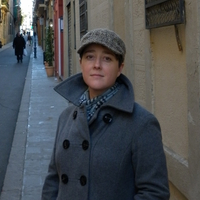
Donna Roberts
Researcher with project Science, Literature and Research: Avant-Garde Encounters with Biology and Ecology, University of Helsinki, Finland.
Writing a monograph on surrealism, natural history, and evolutionary theories titled A Feeling for Nature: Surrealism, from Natural History to Ecology. Focusing on the writings of Roger Caillois, Salvador Dali, Andre Breton, Michel Foucault, Charles Darwin, Henri Bergson, Ernst Haeckel, Alexander von Humboldt, Sigmund Freud, J.H. Fabre, J.B. Lamarck, John Dewey, Gillian Beer, Frank Sulloway, Stephen Jay Gould, Gregory Bateson, Thomas Sebeok, Arne Naess, and others.
Writing a monograph on surrealism, natural history, and evolutionary theories titled A Feeling for Nature: Surrealism, from Natural History to Ecology. Focusing on the writings of Roger Caillois, Salvador Dali, Andre Breton, Michel Foucault, Charles Darwin, Henri Bergson, Ernst Haeckel, Alexander von Humboldt, Sigmund Freud, J.H. Fabre, J.B. Lamarck, John Dewey, Gillian Beer, Frank Sulloway, Stephen Jay Gould, Gregory Bateson, Thomas Sebeok, Arne Naess, and others.
less
Related Authors
Joseph Carroll
University of Missouri - St. Louis
Richard Menary
Macquarie University
Beckett Sterner
Arizona State University
Andrea Peto
Central European University
Dan Hicks
University of Oxford
Benjamin Noys
University of Chichester
paula roush
London South Bank University
David Seamon
Kansas State University
J. H. Chajes
University of Haifa
Romy Golan
Graduate Center of the City University of New York
InterestsView All (15)










Uploads
Conference Presentations by Donna Roberts
The connection between surrealism and Bergson's ideas has received relatively little critical scrutiny. While conspicuous, given a general accord regarding a rejection of positivism and a sense of the limits of scientific knowledge, the reasons for this oversight might be identified in terms of the vicissitudes of Bergson's reputation and the historical shifts in the critical focus on his work. By the time André Breton had published his Manifesto of Surrealism (1924), Bergson's philosophical star was waning, and it is most likely that the association of Bergsonism with the deeply conservative 'spiritualism' lingering over from the previous decade largely determined Breton's circumspection towards ties with the philosopher. Furthermore, it is only since the growing absorption of Gilles Deleuze's reappraisal of Bergson's significance-as well as the deeper critical facilitation of evolutionary theory within philosophy and the humanities at large-that Bergson's philosophically and politically redeemed writings can be seen more clearly to relate to certain key principles of surrealism: most notably, a vital affirmation of life in all its complexity and excess. This paper will explore the ways in which a post-Deleuzian reading of Bergson might open up a clearer picture of the relations between the philosopher of the élan vital and an intellectual movement that, perhaps more than any in the modernist era, embraced the radically transformative possibilities of an open-ended, spontaneously creative principle of life and art.
Callois' highly idiosyncratic text utilises his readings of as diverse figures as Freud, Leibniz, Strindberg, and Enlightenment materialist philosophers in order to construct the argument that poetic correspondences, chains of associative thought, and ideogrammatic motifs recurrent throughout dreams, poetry and folklore have nothing to do with chance but, rather, are highly determined by the fact that the structure of the human imagination is continuous with the structure of the natural world at large.
The paper discusses the development of Roger Caillois' critical and comparative method and his role as a surrealistic 'Encyclopedist'. It addresses the influence of surrealism on Caillois' concerns with drawing together apparently paradoxical or distinct objects of study and how he developed this method into an interdisciplinary approach he called 'Diagonal Science'. The paper discusses Caillois' personal collection of artistic and natural objects, and how they reflect his interest in bridging science and poetics and his notion of the latter as "the science of correspondences".
Donna Roberts
University of Helsinki
Conference paper, EAM, Rennes 2016: 'Quest and Investigation'
During his studies in comparative religion and mythology in the early 1930s, Roger Caillois developed a form of analysis and exegesis that brought together a scholarly method of comparison with a surrealist imperative to draw together apparently irreconcilable phenomena. His first exercises in this alliance of avant-garde, scholarly and scientific practice brought together entomology, biology, psychoanalysis, and mythology in two texts published in the surrealist periodical Minotaure in the mid-1930s. The comparative method enabled Caillois to pursue a highly surrealist taste for paradox and rapprochement that was intended to disturb given ontologies – such as those distinguishing humans from insects – and, through a form of shock encounter, open up new perspectives for research.
Caillois combined scholarly method with the poetic structures of surrealist thought. Drawing on nineteenth-century French romanticism, with its methods of correspondence, analogy, and a poetic logic that ran counter to the classical principle of non-contradiction, Caillois transposed the bold synthesizing leaps of poetic thinking onto a discursive plane. Although he had already retired from the surrealist group at the time of the Minotaure publications, Caillois would go on to develop a form of surrealist epistemology premised on broadening knowledge through comparative method and surprising encounter.
Caillois held to Marcel Mauss’ image of the spider’s web as the model for the connective tissue of mind and world. Drawing on Baudelaire’s notion of correspondences, he would develop his notion of ‘Diagonal Sciences’ as a model for uncovering hidden relations, and in 1953 established the interdisciplinary journal Diogenes as an organ for his ‘diagonal’ approach. This paper will discuss the development of Caillois’ thinking, and look at how his ‘adventurous coherency’ can be compared with more recent advances in interdisciplinarity and systemic thinking.
This paper will discuss H.G. Wells’ and Julian Huxley’s The Science of Life, examining how their interpretation of evolutionary psychology, man’s place within nature, and their Darwinian rejection of a teleological notion of progress reflect a range of modernist concerns, including collectivity, play, eroticism, and the embodied mind.
Dr Donna Roberts (Independent Scholar), Helsinki
These days, largely due to the writings of Michel Foucault, “curiosity” has become a term seemingly loaded with epistemological edginess. The term is so ubiquitous that it can be found anywhere from publicity for Ripley’s Believe it or Not! museum to the website of the Welcome Collection; a term that is used, basically, with the hope of inciting a certain form of passing interest. However, thanks to a host of scholars who have developed a rich history of this term, we know that curiosity is understood to have played a crucial cognitive role from Aristotelian natural philosophy through to the most current scientific method.
It is arguable, however, that a critical awareness of these two strands of curiosity – relating to the appeal (and taxonomical intrigue) of rarity and its incitement of the cognitive drive – was developed considerably earlier than recent discourse might suggest, that is, within the surrealist milieu in the first half of the twentieth century. Foucault’s familiarity with the work of André Breton, Georges Bataille, and Roger Caillois suggests a fairly linear legacy from the varieties of surrealist method and analysis through to contemporary discourse on curiosity. Breton utilized curiosity in terms of the marvelous, as a means to challenging dominant ideas about the proper objects of knowledge; Bataille drew on his scholastic training to develop an aggressively affective visual method that exploited the monstrous appeal and vice of curiosity in a critique of European cultural and philosophical idealism; while Caillois turned his attention to curiosities of nature as a means of exploring disturbing continuities between human and non-human behaviour.
The exhibitions and periodicals organized within the surrealist milieu have long been interpreted as creative and provocative forms of cabinets of curiosity, utilizing the surrealist method of juxtaposition to produce lyrical and unsettling relationships that question orthodoxies concerning the order of things. The combining of heteroclite images, objects and texts was developed according to key critical intentions: a de-centering of European civilization, an assault on the idea of a dispassionate aesthetic, and a reconfiguring of the marvelous as part of a refusal of the reductions of positivist science.
With a view to contributing to the historiographical interests of the conference, this paper will examine how the surrealists elevated the notion of curiosity into a radical form of enquiry that would become key to the movement’s broad political, historical, ethnographic, and cultural critique. Given that the coherency of the surrealist programme and its abiding political commitments provided structure and critical force to its engagement with curiosity as both a boundless cognitive drive and a potentially subversive property of material culture, I will ask whether, in lacking such a coherent programme, much of the contemporary engagement in curiosity (thinking of yet another stuffed animal) risks coming across as an uncritical, nostalgic, fetishistic, sublimating, and overly-aestheticised indulgence in artefacts and the pat elaborations of the ‘boundary-breaking’ rhetoric of inter-disciplinarity.
Conference paper, EAM, Helsinki, 2014
Following WWI, the surrealists rejected a seemingly blind belief in the notion of “progress”, as theorised by the philosophers of the French Republic from Condorcet to Comte. In response to the over-privileging of scientific reasoning in the modern age, the surrealists used a Freudian pre-historical topos to outline the fact that, however technologically advanced, humankind is irrefutably defined by instincts that were determined by early biological and social development. Ernst Haeckel’s theory of recapitulation was fundamental to Freud’s thinking on the correlations between the development of the individual and the species. Freud used this ‘Biogenetic Law’ in his theory of the neuroses, positing that different stages in individual life corresponded with different stages in human pre-history. At the turn of the twentieth century, literature and popular culture were replete with images of atavistic regressions and the return to more primitive states of being, and the surrealists engaged with this in an imaginative and provocative manner. This paper will discuss how surrealist concerns with the “primitive” were underpinned by the influence of evolutionary theories, and that the surrealists utilised (both directly and indirectly) an evolutionary discourse within their critique of the dominant positivist vision of social and cultural progress
Donna Roberts
Proposal
Spectres of Regression: Dismal Darwinism, Freud, and Surrealist Metapsychology
This paper will focus on the spectre of regression that developed through late 19th century natural science and psychology, and in turn came to underline key areas of surrealist art and writing, particularly in the 1930s. The surrealists exploited, through the image of regressive transformation or atavistic affinity, anxieties long prompted by evolutionary theory and the possibility that human development could be terrifyingly reversed.
The readings of Freud’s work that have dominated discourse in art history, as elsewhere in the humanities, have predominantly avoided discussion of the biological foundations of his theories. Following the argument of Frank J. Sulloway’s Freud Biologist of the Mind, I will discuss how the psychoanalytic whitewashing of Freud’s biological grounding in the theories of Darwin and Lamarck has hidden from view some essential points concerning his ideas on human development. Freud’s biogenetically grounded ideas concerning the primal and the civilized, repression and the instincts, progress and regression, would find strong echoes in surrealist discourse, revealing a kind of biological unconscious of surrealism.
Like many of his generation, before the genetic synthesis had established Darwin’s theory of natural selection, Freud looked less to Darwin and more to Lamarck’s ideas for answers to issues of inheritance and the primal experiences and memories that he believed phylogenetically structured the neuroses in the civilized adult. Freud’s so-called Phylogenetic Fantasy will be discussed as outlining the bases of his metapsychology in biogenetic theories, and as an extraordinarily imaginative speculation about the primal origins of society and their influence on human development. This text will then be explained in relation to Salvador Dalí’s Tragic Myth, which, I will argue, follows Freud’s text with its own ‘phylogentic fantasy’ of a bestial return to the form of an enormous praying mantis; a narrative that in turn echoes the evolutionary-inspired tales of H.G Wells and the world of fantasy fiction with which Dalí was familiar.
I will then discuss how these key biogenetic elements of Freudian metapsychology fed into a surrealist discourse that privileged the expression of the instincts, and which paraded regression in the face of the bourgeois dependency on a progressive scientific discourse. Alongside a far more optimistic and aesthetic discourse on the natural history of the marvelous, this pessimistic discourse played grotesquely with images of regression. Rather than Bretonian revolution, many within the surrealist milieu invoked a force of involution, as exemplified in Salvador Dalí’s persistent rhetoric of regression, Roger Caillois’ entomological avatars of bestiality and self-immolation, Georges Bataille’s embrace of the violently regressive throughout Documents, and Luis Buñuel’s hymn to non-productive instincts, L’Age d’Or.
Notably, in their imaginary metamorphoses and perverse positing of terrible affinities, the surrealists did not invoke the evolutionary phantom of the ape, but rather, the uncanny human other of the insect, Henri Bergson’s instinctual pole to human intelligence. I will, then, argue that between the wars the surrealists presented a powerful provocation to the essentially Lamarckian values that for decades had guided the French Republican rhetoric of progress, science and civilization which had molded the religious and political resistance to Darwin’s ideas in France.
This provocation I will define as dismal Darwinism. Through their recurrent conflation of human-insect affinity or fantastical metamorphoses, the surrealists exploited the anxieties of evolutionary origins, affronting with the pessimistic and atavistic spectre of return the dominant ideological framework that had so conspicuously held on to the possibilities of Lamarckian progress.
The entropic character of Las Pozas, the intentional ruination and engulfing of its manmade structures, has posed many questions for the Mexican conservators, who have managed the site with great subtlety. The destabilizing space, thick with humidity, in which one climbs up and down narrow twisting staircases, and across precarious walkways up to the cascading pools, from which the site takes its name, is a physically exhausting adventure in which the ontological topsy-turviness of nature and artifice, along with the colonialist semiotics within the tropical environment, affect a form of vertigo in which, in Roger Caillois’ terms, a form of psychasthenic space envelops the traveler, destabilizing spatial and temporal certainty.
A surrealist reading of Las Pozas will be countered with the critique offered by Melanie Smith’s recent video installation of the site, Xilitla (2010), in which the British Mexican-based artist takes up the trope of Robert Smithson’s Mirror Displacements (1969), and dismantles the oneiric space of James’ site with the roving eye of a mirror carried by the gardeners.
"
Chapters by Donna Roberts
The connection between surrealism and Bergson's ideas has received relatively little critical scrutiny. While conspicuous, given a general accord regarding a rejection of positivism and a sense of the limits of scientific knowledge, the reasons for this oversight might be identified in terms of the vicissitudes of Bergson's reputation and the historical shifts in the critical focus on his work. By the time André Breton had published his Manifesto of Surrealism (1924), Bergson's philosophical star was waning, and it is most likely that the association of Bergsonism with the deeply conservative 'spiritualism' lingering over from the previous decade largely determined Breton's circumspection towards ties with the philosopher. Furthermore, it is only since the growing absorption of Gilles Deleuze's reappraisal of Bergson's significance-as well as the deeper critical facilitation of evolutionary theory within philosophy and the humanities at large-that Bergson's philosophically and politically redeemed writings can be seen more clearly to relate to certain key principles of surrealism: most notably, a vital affirmation of life in all its complexity and excess. This paper will explore the ways in which a post-Deleuzian reading of Bergson might open up a clearer picture of the relations between the philosopher of the élan vital and an intellectual movement that, perhaps more than any in the modernist era, embraced the radically transformative possibilities of an open-ended, spontaneously creative principle of life and art.
Callois' highly idiosyncratic text utilises his readings of as diverse figures as Freud, Leibniz, Strindberg, and Enlightenment materialist philosophers in order to construct the argument that poetic correspondences, chains of associative thought, and ideogrammatic motifs recurrent throughout dreams, poetry and folklore have nothing to do with chance but, rather, are highly determined by the fact that the structure of the human imagination is continuous with the structure of the natural world at large.
The paper discusses the development of Roger Caillois' critical and comparative method and his role as a surrealistic 'Encyclopedist'. It addresses the influence of surrealism on Caillois' concerns with drawing together apparently paradoxical or distinct objects of study and how he developed this method into an interdisciplinary approach he called 'Diagonal Science'. The paper discusses Caillois' personal collection of artistic and natural objects, and how they reflect his interest in bridging science and poetics and his notion of the latter as "the science of correspondences".
Donna Roberts
University of Helsinki
Conference paper, EAM, Rennes 2016: 'Quest and Investigation'
During his studies in comparative religion and mythology in the early 1930s, Roger Caillois developed a form of analysis and exegesis that brought together a scholarly method of comparison with a surrealist imperative to draw together apparently irreconcilable phenomena. His first exercises in this alliance of avant-garde, scholarly and scientific practice brought together entomology, biology, psychoanalysis, and mythology in two texts published in the surrealist periodical Minotaure in the mid-1930s. The comparative method enabled Caillois to pursue a highly surrealist taste for paradox and rapprochement that was intended to disturb given ontologies – such as those distinguishing humans from insects – and, through a form of shock encounter, open up new perspectives for research.
Caillois combined scholarly method with the poetic structures of surrealist thought. Drawing on nineteenth-century French romanticism, with its methods of correspondence, analogy, and a poetic logic that ran counter to the classical principle of non-contradiction, Caillois transposed the bold synthesizing leaps of poetic thinking onto a discursive plane. Although he had already retired from the surrealist group at the time of the Minotaure publications, Caillois would go on to develop a form of surrealist epistemology premised on broadening knowledge through comparative method and surprising encounter.
Caillois held to Marcel Mauss’ image of the spider’s web as the model for the connective tissue of mind and world. Drawing on Baudelaire’s notion of correspondences, he would develop his notion of ‘Diagonal Sciences’ as a model for uncovering hidden relations, and in 1953 established the interdisciplinary journal Diogenes as an organ for his ‘diagonal’ approach. This paper will discuss the development of Caillois’ thinking, and look at how his ‘adventurous coherency’ can be compared with more recent advances in interdisciplinarity and systemic thinking.
This paper will discuss H.G. Wells’ and Julian Huxley’s The Science of Life, examining how their interpretation of evolutionary psychology, man’s place within nature, and their Darwinian rejection of a teleological notion of progress reflect a range of modernist concerns, including collectivity, play, eroticism, and the embodied mind.
Dr Donna Roberts (Independent Scholar), Helsinki
These days, largely due to the writings of Michel Foucault, “curiosity” has become a term seemingly loaded with epistemological edginess. The term is so ubiquitous that it can be found anywhere from publicity for Ripley’s Believe it or Not! museum to the website of the Welcome Collection; a term that is used, basically, with the hope of inciting a certain form of passing interest. However, thanks to a host of scholars who have developed a rich history of this term, we know that curiosity is understood to have played a crucial cognitive role from Aristotelian natural philosophy through to the most current scientific method.
It is arguable, however, that a critical awareness of these two strands of curiosity – relating to the appeal (and taxonomical intrigue) of rarity and its incitement of the cognitive drive – was developed considerably earlier than recent discourse might suggest, that is, within the surrealist milieu in the first half of the twentieth century. Foucault’s familiarity with the work of André Breton, Georges Bataille, and Roger Caillois suggests a fairly linear legacy from the varieties of surrealist method and analysis through to contemporary discourse on curiosity. Breton utilized curiosity in terms of the marvelous, as a means to challenging dominant ideas about the proper objects of knowledge; Bataille drew on his scholastic training to develop an aggressively affective visual method that exploited the monstrous appeal and vice of curiosity in a critique of European cultural and philosophical idealism; while Caillois turned his attention to curiosities of nature as a means of exploring disturbing continuities between human and non-human behaviour.
The exhibitions and periodicals organized within the surrealist milieu have long been interpreted as creative and provocative forms of cabinets of curiosity, utilizing the surrealist method of juxtaposition to produce lyrical and unsettling relationships that question orthodoxies concerning the order of things. The combining of heteroclite images, objects and texts was developed according to key critical intentions: a de-centering of European civilization, an assault on the idea of a dispassionate aesthetic, and a reconfiguring of the marvelous as part of a refusal of the reductions of positivist science.
With a view to contributing to the historiographical interests of the conference, this paper will examine how the surrealists elevated the notion of curiosity into a radical form of enquiry that would become key to the movement’s broad political, historical, ethnographic, and cultural critique. Given that the coherency of the surrealist programme and its abiding political commitments provided structure and critical force to its engagement with curiosity as both a boundless cognitive drive and a potentially subversive property of material culture, I will ask whether, in lacking such a coherent programme, much of the contemporary engagement in curiosity (thinking of yet another stuffed animal) risks coming across as an uncritical, nostalgic, fetishistic, sublimating, and overly-aestheticised indulgence in artefacts and the pat elaborations of the ‘boundary-breaking’ rhetoric of inter-disciplinarity.
Conference paper, EAM, Helsinki, 2014
Following WWI, the surrealists rejected a seemingly blind belief in the notion of “progress”, as theorised by the philosophers of the French Republic from Condorcet to Comte. In response to the over-privileging of scientific reasoning in the modern age, the surrealists used a Freudian pre-historical topos to outline the fact that, however technologically advanced, humankind is irrefutably defined by instincts that were determined by early biological and social development. Ernst Haeckel’s theory of recapitulation was fundamental to Freud’s thinking on the correlations between the development of the individual and the species. Freud used this ‘Biogenetic Law’ in his theory of the neuroses, positing that different stages in individual life corresponded with different stages in human pre-history. At the turn of the twentieth century, literature and popular culture were replete with images of atavistic regressions and the return to more primitive states of being, and the surrealists engaged with this in an imaginative and provocative manner. This paper will discuss how surrealist concerns with the “primitive” were underpinned by the influence of evolutionary theories, and that the surrealists utilised (both directly and indirectly) an evolutionary discourse within their critique of the dominant positivist vision of social and cultural progress
Donna Roberts
Proposal
Spectres of Regression: Dismal Darwinism, Freud, and Surrealist Metapsychology
This paper will focus on the spectre of regression that developed through late 19th century natural science and psychology, and in turn came to underline key areas of surrealist art and writing, particularly in the 1930s. The surrealists exploited, through the image of regressive transformation or atavistic affinity, anxieties long prompted by evolutionary theory and the possibility that human development could be terrifyingly reversed.
The readings of Freud’s work that have dominated discourse in art history, as elsewhere in the humanities, have predominantly avoided discussion of the biological foundations of his theories. Following the argument of Frank J. Sulloway’s Freud Biologist of the Mind, I will discuss how the psychoanalytic whitewashing of Freud’s biological grounding in the theories of Darwin and Lamarck has hidden from view some essential points concerning his ideas on human development. Freud’s biogenetically grounded ideas concerning the primal and the civilized, repression and the instincts, progress and regression, would find strong echoes in surrealist discourse, revealing a kind of biological unconscious of surrealism.
Like many of his generation, before the genetic synthesis had established Darwin’s theory of natural selection, Freud looked less to Darwin and more to Lamarck’s ideas for answers to issues of inheritance and the primal experiences and memories that he believed phylogenetically structured the neuroses in the civilized adult. Freud’s so-called Phylogenetic Fantasy will be discussed as outlining the bases of his metapsychology in biogenetic theories, and as an extraordinarily imaginative speculation about the primal origins of society and their influence on human development. This text will then be explained in relation to Salvador Dalí’s Tragic Myth, which, I will argue, follows Freud’s text with its own ‘phylogentic fantasy’ of a bestial return to the form of an enormous praying mantis; a narrative that in turn echoes the evolutionary-inspired tales of H.G Wells and the world of fantasy fiction with which Dalí was familiar.
I will then discuss how these key biogenetic elements of Freudian metapsychology fed into a surrealist discourse that privileged the expression of the instincts, and which paraded regression in the face of the bourgeois dependency on a progressive scientific discourse. Alongside a far more optimistic and aesthetic discourse on the natural history of the marvelous, this pessimistic discourse played grotesquely with images of regression. Rather than Bretonian revolution, many within the surrealist milieu invoked a force of involution, as exemplified in Salvador Dalí’s persistent rhetoric of regression, Roger Caillois’ entomological avatars of bestiality and self-immolation, Georges Bataille’s embrace of the violently regressive throughout Documents, and Luis Buñuel’s hymn to non-productive instincts, L’Age d’Or.
Notably, in their imaginary metamorphoses and perverse positing of terrible affinities, the surrealists did not invoke the evolutionary phantom of the ape, but rather, the uncanny human other of the insect, Henri Bergson’s instinctual pole to human intelligence. I will, then, argue that between the wars the surrealists presented a powerful provocation to the essentially Lamarckian values that for decades had guided the French Republican rhetoric of progress, science and civilization which had molded the religious and political resistance to Darwin’s ideas in France.
This provocation I will define as dismal Darwinism. Through their recurrent conflation of human-insect affinity or fantastical metamorphoses, the surrealists exploited the anxieties of evolutionary origins, affronting with the pessimistic and atavistic spectre of return the dominant ideological framework that had so conspicuously held on to the possibilities of Lamarckian progress.
The entropic character of Las Pozas, the intentional ruination and engulfing of its manmade structures, has posed many questions for the Mexican conservators, who have managed the site with great subtlety. The destabilizing space, thick with humidity, in which one climbs up and down narrow twisting staircases, and across precarious walkways up to the cascading pools, from which the site takes its name, is a physically exhausting adventure in which the ontological topsy-turviness of nature and artifice, along with the colonialist semiotics within the tropical environment, affect a form of vertigo in which, in Roger Caillois’ terms, a form of psychasthenic space envelops the traveler, destabilizing spatial and temporal certainty.
A surrealist reading of Las Pozas will be countered with the critique offered by Melanie Smith’s recent video installation of the site, Xilitla (2010), in which the British Mexican-based artist takes up the trope of Robert Smithson’s Mirror Displacements (1969), and dismantles the oneiric space of James’ site with the roving eye of a mirror carried by the gardeners.
"
Donna Roberts, “Surrealism and Natural History: The Marvellous in Breton and Caillois”
Published in: A Companion to Dada and Surrealism, David Hopkins (ed.). Wiley & Blackwell, 2016.
Key words: Surrealism, nature, André Breton, Roger Caillois, Rousseau, Romanticism, automatism, Art Nouveau, Vegetal Delirium, Martinique: Snake Charmer, Foucault, The Order of Things, taxonomies, minerals, “demon of analogy,” Strindberg, Goethe, marvellous, Cabinets of Curiosity, Wunderkammer, Dalí, L’Amour fou/Mad Love, praying mantis.
This text addresses the theme of natural history in surrealist thought, focusing on the writings of Louis Aragon, André Breton, and Roger Caillois. A central point of analysis concerns the surrealists’ interest in blurring the relations between nature and culture, and the trans-historical alignment between the Early Modern epistemological structure of similitude with the core dynamics of surrealist lyrical thinking.
Opening with Aragon's account in of a surrealist adventure into the Parc des Buttes Chaumont, it explores various aspects of the surrealist sensibility for nature, captured so evocatively in Aragon's meditation in Paris Peasant upon "a feeling for nature": a primal, mythical emotion for which Aragon seeks a modern manifestation in the ersatz picturesque/sublime surroundings of the rather shady park.
The text then looks to the neo-Romanticism of the chapter of Mad Love based on Breton's experiences in Tenerife, in which he develops a lyrical eroticism relating the symbiosis of his new love to that of the unique natural environment of the island made famous by the ecologist Alexander von Humboldt. An analysis of Breton's "nature writing" continues with an account of the “Creole Dialogue” between Breton and André Masson, in which they reflect upon the psychological and physiological affect of tropical vegetation, its overwhelming allure, and how it represents a natural force analogous with the creative imagination.
The final section looks at the mutual interest of Breton and Caillois in minerals and pictographic stones, which are discussed as an element of the surrealist engagement with the historical relationship between marvellous objects and the cabinet of curiosity or Wunderkammer. A distinction is made between Breton’s commitment to the personal hermeneutics constructed through seemingly objective “signs” and Caillois’ relative circumspection about the overdetermination of visual resemblances; a wayward analogical drive he defines as the “demon of analogy.” The chapter concludes that for surrealists like Breton and Caillois, natural history did not only provide an aesthetic or lyrical appeal, but that it also influenced the development of surrealist method, through attention to curiosity, apparent laws and exceptions, and comparative analysis.
http://www.flintmagazine.org/
KEYWORDS: Bergson, Caillois, evolution, biology, insects, instinct, myth, society
Ce texte se concentre sur l'influence des idées d'Henri Bergson à propos de l'instinct, de l'intelligence et du mythe sur l'œuvre de Roger Caillois. Mon objectif est de proposer une lecture de l'histoire intellectuelle qui ramène Bergson dans l'orbite de l'avant-garde française des années 1930. Ce faisant, je souligne la présence axiomatique des idées de Bergson dans l'œuvre de Caillois, qui peut être décrite comme la combinaison d'études philosophiques, culturelles et de sciences sociales contemporaines avec la méthode surréaliste, notamment illustrée par la juxtaposition improbable de l'étude des relations entre le comportement des insectes et la fonction de création de mythes chez l'homme. Alors que la réception historique des idées de Bergson a largement montré le déclin de son influence dans la période de l'entre-deux-guerres, je souhaite présenter un cas concret dans lequel la pensée de Bergson a continué à avoir une influence formatrice. Les études sur le surréalisme partent largement du principe que Bergson a été entièrement rejeté par le mouvement pour des raisons politiques. Je soutiens que les idées de Bergson étaient en fait au cœur des écrits de Caillois sur les insectes et la société. En plus de mettre en évidence le noyau bergsonien de certaines des œuvres clés de Caillois en tant que membre du groupe surréaliste et du Collège de sociologie, je propose que la présence des idées de Bergson dans ce milieu radical contribue à la discussion en cours sur l'influence et l'héritage du philosophe.
Published in Metascience (2016) 25: 429-432